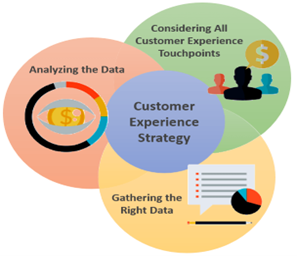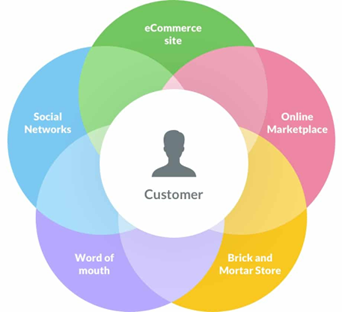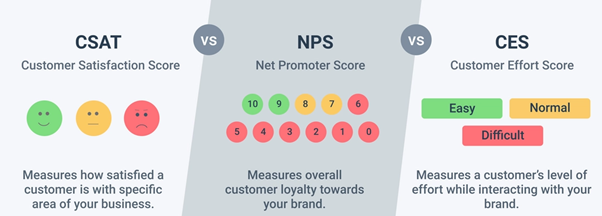MSc Management Customer Experience Strategy Assignment Sample 2023
Introduction
The Customers Experience (CX) is all about measuring the perception and feelings regarding the product and services of the company through detailed interaction which mediates the brand reputation and high market conversion and is crucial for competitive market advantage. In this report, the services of the Taj Hotel of India and its CX strategy through consumer persona creation and customer journey map, Omni channel marketing, CX performance metrics and process with comparison to different industries will be discussed elaborately.
1. The importance of customer experience
Becker and Jaakkola, (2020) stated that Customer experience is the core element of organisational competitiveness and fundamental for marketing management which stimulates the customer’s reactions and responses. The CX strategy is the organisational effort to step forward and resolve the customer problem for delivering satisfaction which ensures high customer loyalty and a greater retention rate with enhanced brand advocacy.
The benefits of the customer experience strategy are greater lifetime value of the customer, reduced customer churn, increased brand equity, improved crisis management, reduced cost services and marketing and better customer engagement. However, the challenges of the CX are communicating repetitive information, lack of personalised customer interaction, not valuing the customer’s time, and lack of knowledge of the agents about the customer and services are siloed from other departments.

Figure 1: Customer Experience strategy
(Source: Popli and Rishi, 2021)
Popli and Rishi (2021) explained the crafting and execution of the CX strategy where Taj hotels and others concentrated on customer engagement and customer-centricity. Taj Hotel is delivering transformative customer experiences by checking all the boxes to engage and meet customer needs effectively (Refer to Appendix 1).
The CX of the Taj hotel encompasses well-decorated five-star physical evidence, the involvement of versatile processes to take care of the customer and their belongings, a diverse range of cuisines and the introduction of technology for increased satisfaction. Furthermore, the challenges of CX in Taj Hotel comprise cultural integration, commitment and flexibility which largely depend on the employee’s skill, knowledge and practices in engaging with the global citizens.
2. Consumer persona creation
Consumer persona creation helps the organisation to effectively actualise the consumer requirements and expectations from the product and services of the company through which the organisation tailored its marketing effort for the right people. It benefits the company by giving valuable insights into consumer interest in the product and influences the marketing communication for targeted advertisements.
In addition to that, Buhalis and Sinarta, (2019) mentioned that real-time services offer dynamic engagement with the connected consumer whereas technological interference offers the transformation of services into co-creation through mobilising resources for the consumer persona through conceptualising differences. The challenges of consumer persona are lack of regular updates and reviews, misidentification of persona, making assumptions and largely focusing on demographics.
| Demography and story | Name – Rakesh Tripathi
Age -35 years Gender- Male Marital Status- Single Location- Delhi |
| Profile | I am an investment banker and a travel freak and most of my holidays I used to travel around different cities and for experiencing the multithreaded geography, demography and cultural parameters of the Country |
| Motivation for using the services | Availability at different corners of the country with the outstanding hospitality services |
| Goals for using the services | Five-star hospitality services blended with Indian culture and heritage |
| Painpoints resolved through Taj hotel services | Provides good sight, cosiness, luxury hotel services, extraordinary and spicy cuisines, and integrated travel services with tour guides around the city and downtown |
Table 1: Customer persona creation
(Source: Self-created)
3. Customer journey map
The customer journey map is the visual storyline of the detailed engagement and interactions of the customers with the brand product and services which indulges the organisation Taj Hotel directly in the consumers’ thought process and overall experience. Gallan et al., (2021) articulated that the customer journey map for the organisation helps to self-assess the organisational stand in the respective customer’s journey with the brand product and services to become a transformative organisation.
Moreover, the customer’s journey map enables the organisation to put it into the customer’s shoes and identify the unmet needs of the customer, visualise the customer’s emotions as well as create personalised services.
Customer journey map
| Stages of journey | Awareness | Consideration | Decision | Service | Loyalty |
| Customer’s concern and Action | Social media, YouTube, online ads, information from colleagues and friends | Checked in internet and company websites | Booked rooms in Taj hotel | Received quality services, best hygiene practices and tour guidance | Referred to friends, colleagues and management for its integrated services |
| Touchpoints | Traditional media channels | Social media | Online booking | Company websites and marketing messages | Review, word of mouth |
| CX | Excited | Inquisitive | Enthusiastic | Excellent | Fascinated |
| Key performance
Indicators (KPI) |
Developing strategy | Generate everyday new visitor | E-commerce strategies | Satisfied and contented customers | High retention rate |
| Business objectives | Delivering customised strategy according to different customer | Increased traffic to the website | High conversion rate | More satisfied clients and regular check-ins | Positive review and acceleration of satisfied customer base |
| Teams involved | Business development and marketing team | Sales and marketing teams for increased communication | Technological emergence in use and employee adaptability | Employees, cooks, waiters, travel guides | Upholding customer satisfaction and retention with excellent offerings and services |
Table 2: Customer journey map
(Source: Self-created)
4. Omni channel marketing
Definition of Omnichannel Marketing
Omnichannel marketing may be defined as the strategic approach of an organisation for the provision of seamless service to consumers across different touchpoints irrespective of the nature of the channel used by the consumer. The key concern of Omnichannel Marketing is to form an adequate well-established relationship between the consumers and the company by giving a seamless appearance in service and marketing by using tactful strategies and initiatives (Payne et al., 2017).
The Role of Customisation and Interaction in OmniChannel Marketing
Customisation or personalization in the Omnichannel Marketing method is the process of data-oriented efforts by an organisation to meet the customer requirements by observing the customer experiences through various channels, especially the digital ones. Several factors namely brand credibility, technological upgradation, and customisation also play a pivotal role in the advancement of overall seamless consumer experiences through Omnichannel Marketing Strategy (Hickman et al., 2020).
Omnichannel marketing is fast becoming a key concern in the understanding and seamless accomplishments of consumer needs and experiences with subsequent feedback and recommendations that will enhance the brand value of the organisation.

Figure 2: Interaction in Omnichannel Marketing
(Source: Rodríguez et al., 2020)
Interaction in Omnichannel Marketing also is one of the potent factors of the efforts taken for the seamless service towards the customers regarding the demands and experiences. On a broader note, the prior objective of interaction in the Omnichannel marketing method is to preserve the continuity and smooth interchange of the ideas, feedback and necessities between the consumers and the enterprise (Rodríguez et al., 2020).
Different channels such as ecommerce sites, online marketplaces, Brick and Mortar stores, Words of Mouth, and Social Networking Sites are engaged in the Omnichannel process.
Identification of Different Marketing Channels of Taj Hotel
Social Media Marketing
The Taj Group of Hotels in India is increasingly recognized as a socially boosted organisation as the company is engaged in social media platforms for the endorsement of the services. Twitter, Facebook, Youtube, Pinterest and Instagram are some of the social media marketing channels Used by the company for marketing and customer involvement (Refers to Appendix 2)
Print Media
The Taj Magazine is the renowned print media marketing channel of The Taj hotel where the company used to keep the customers informed about the cultures that have followed (Tajhotels.com. 2022). Apart from this, luxury travel magazine is also the print media sponsor of the advertisements for Taj Hotel.
Search Engine Optimization (SEO)
Taj Hotel uses search engines as marketing channels for the betterment of customer interactions and engagement which includes relevant information on the hotel-related facilities. Moreover, Google search ads are also an integral part of the marketing strategy of The Taj Group of Hotels to involve the customers vividly (Singh, 2022).
Effectiveness of the Taj Hotel to meet the seamless Customer Journey
The channels used by the Taj Hotel regarding the marketing and customer interactions for the providence and distribution of services enhanced the seamless approach to the customer journey. The social media interactions and displays are involving more customers both in India and overseas.
The barriers that may have occurred from online marketing will be eradicated by the effective print media marketing of this company such as brochures and magazines. Own websites and search engine ads are also effective marketing tools for the Taj Hotel.
5. CX performance matrix
Net Promoter Score (NPS)
The CX performance matrix Net Promoter Score is the evaluative self-assessment of any organisation from the standpoint of customer experiences and feedback. Moreover, NPS gives the numerical denotation of the nature of customer experience to the leaders for the development of targets and strategies. The calculation of NPS is usually done by the differences between the promoter and detractor customers on a percentage-based approach. The range from 0 to 6 are labelled as detractors, ranks 7 and 8 are known as passive and the 9 and 10 are inclined to promoters (Refer to Appendix 3).
Customer Satisfaction (CSAT)
Customer satisfaction is the second important CX matrix that deals with the satisfaction of the customer regarding any services provided by the organisation. Customer satisfaction and customer experience play a cause-effect scenario that results in achieving a competitive advantage for the organisation nowadays mostly based on online ratings (Illescas et al., 2022). The scalar measurements or gradations of the services on behalf of the consumers as excellent, good, average, poor and extremely bad are being done by the CSAT performance matrix of CX.

Figure 3: CX performance metrics
(Source: Illescas et al., 2022)
Customer Effort Score (CES)
The third CX performance matrix is the Customer Effort Score which measures the amount of the attempt or importance given by a consumer throughout the customer journey. On a broader note, CES denotes the parameter of CX performance that organises services to smooth customer interactions. CES measures the probability of the solution of an issue from the viewpoint of customers by the scalar analysis of a 5 or 7-point scale system.
Customer Churn Rate
The Customer Churn rate indicates the ratio of the customers who have already withdrawn the services to the existing customers up to that point in time (Ahn et al., 2020). Briefly, the churn rate is vital for the customer experience scenario for an organisation as the factor represents the value of the lost business. The calculation of the churn rate is done by the ratio of the quarterly loss and beginning number of consumers of an organisation and effectiveness for customer retention
Selection for two metrics for Taj Hotels
Taj’s group of hotels needs to focus on the NPS system to focus on the promoter and detractor approaches of the customers regarding the experiences and feedback along with passive factors. CES will also have to be the focus of this organisation to emphasise the efforts and inputs given by the customers concerning the services and experiences. The main advantages of using NPS and CES are enhancing customer involvement and spontaneity regarding the customer experiences with services.
6. CX process in different industries
CX processes differ in different industries and here the CX process of Taj hotel is compared with the electronics industry giant Samsung to actualise the effectiveness of the CX strategy of Taj hotel in gaining high market confidence, conversion, retention and market profit. Rahimian et al., (2020) pointed out that CX is the concept of business performance in current times for the organisation which mediates the distinctive features of customer engagement to deliver a satisfying experience to develop increased customer loyalty.
Customer centricity
Customers are the heart and soul of every business engagement and conduction where Taj hotel swiftly coordinates the customer’s services through multiple mobiles and contactless solutions for a safe, secure and seamless guest experience. Pandey, (2021) asserted that the Indian hotel industry, specifically Taj hotel, adopted the CRM technology to manage and communicate with the customer as a customer-centric approach.
On the other hand, Samsung has updated the support site to cope with the increased demand from customers during the pandemic in responding to the soaring volume of traffic on company websites (Martech.org, 2022).
Feedback process
Taj hotel has vociferously articulated its feedback-taking process both in online and offline feedback forms to acknowledge, improve and evolve the services through customer concerns, suggestions and engagement. On the contrary, Samsung electronics usually gave the scope of feedback through its product through the android app for its real-time communication with the technology developers of the Samsung Company.
Onorel, (2019) commented that the feedback process helps to actualise the customer issues and problems with the products and services and enhances the degree of communication between the organisation and customers which also positively influences employee improvement.
Effort measuring
The effort measuring is crucial for acknowledging the organisational effort for better customer engagement where Taj hotel has developed its customer engagement with evolving market trends and customer preferences to attain high customer purchase and satisfaction. Taj hotel has developed its CX strategy to deliver effective and satisfactory services to its customers with incorporating various technology and communication directly with customers.
Holmlund et al., (2020) expressed that customer experience has been conceptualised as a sustainable source of market competitiveness where Big Data Analytics (BDA) possibly unlocked the in-depth customer data and insights for designing a better customer experience strategy. On a different note, the Samsung mobile has generated customer satisfaction through quality products and services with the omnichannel marketing strategy.
Customisable products or services
Customisable products or services are significant elements of customer experience strategy which generate a positive satisfaction ratio and are intended to develop increased customer retention rate and market confidence with increased sales margin and dedicated customer base. Taj hotel has been involved in customising its products and services according to customer choice and intention to effectively align the positive work culture with customer happiness and satisfaction.
The room services, cuisine practices and integrated travel guide fences and transportation in Taj hotel are accommodated according to customer needs and choices to effectively deliver the services to the customer for a better customer experience. On a contradictory note, Samsung used to develop its products and services in a generalised form intended for the global customers with defined and contemporary needs in its products and avoid the customization of the product.
7. Conclusion
It may be concluded that the customer experience strategy is vital for Taj hotel to coordinate its day-to-day business operation by acknowledging the customer requirements to create personalised services and satisfy the visiting customer. It developed increased customer loyalty, retention and positive feedback from the customers and helps in earning better market revenue through increased customer footfall.
It also generalised that Omnichannel marketing is a fruitful event for the company through its engagement in social media as per the market trend and customers’ engagement in the social media platform.
References
Ahn, J., Hwang, J., Kim, D., Choi, H. and Kang, S., 2020. A survey on churn analysis in various business domains. IEEE Access, 8, pp.220816-220839.
Becker, L. and Jaakkola, E., 2020. Customer experience: fundamental premises and implications for research. Journal of the Academy of Marketing Science, 48(4), pp.630-648.
Buhalis, D. and Sinarta, Y., 2019. Real-time co-creation and nowness service: lessons from tourism and hospitality. Journal of Travel & Tourism Marketing, 36(5), pp.563-582.
Gallan, A.S., Kabadayi, S., Ali, F., Helkkula, A., Wu, L. and Zhang, Y., 2021. Transformative hospitality services: A conceptualization and development of organizational dimensions. Journal of business research, 134, pp.171-183.
Hickman, E., Kharouf, H. and Sekhon, H., 2020. An omnichannel approach to retailing: demystifying and identifying the factors influencing an omnichannel experience. The International Review of Retail, Distribution and Consumer Research, 30(3), pp.266-288.search in Interactive Marketing.
Holmlund, M., Van Vaerenbergh, Y., Ciuchita, R., Ravald, A., Sarantopoulos, P., Ordenes, F.V. and Zaki, M., 2020. Customer experience management in the age of big data analytics: A strategic framework. Journal of Business Research, 116, pp.356-365.
Illescas-Manzano, M., Martínez-Puertas, S. and Sánchez-Pérez, M., 2022. The Power of Price and Quality to Explain Customer Satisfaction Through Spatial Analysis. In Contemporary Approaches Studying Customer Experience in Tourism Research (pp. 245-265). Emerald Publishing Limited.
Martech.org, 2022. How Samsung transformed their customer experience with a new support site search. [online] MarTech. Available at: <https://martech.org/how-samsung-transformed-their-customer-experience-with-a-new-support-site-search/> [Accessed 28 September 2022].
Onorel, P.B., 2019. The Importance of Feedback in Organizational Communication. Social-Economic Debates, 8(1), pp.30-38.
Pandey, C.A., 2021. Indian Hotel Industry: Past, Present and Future.
Payne, E.M., Peltier, J.W. and Barger, V.A., 2017. Omni-channel marketing, integrated marketing communications and consumer engagement: A research agenda. Journal of Re
Popli, S. and Rishi, B., 2021. Customer Experience Management–The Road Ahead. In Crafting Customer Experience Strategy (pp. 199-218). Emerald Publishing Limited.
Rahimian, S., ShamiZanjani, M., Manian, A. and Esfiddani, M.R., 2020. Developing a Customer Experience Management Framework in Hoteling Industry: A Systematic Review of Theoretical Foundations. Journal of Business Management, 12(3), pp.523-547.
Rodríguez-Torrico, P., Trabold Apadula, L., San-Martín, S. and San José Cabezudo, R., 2020. Have an omnichannel seamless interaction experience! Dimensions and effect on consumer satisfaction. Journal of Marketing Management, 36(17-18), pp.1731-1761.
Singh, A., 2022. Role of Digital Marketing in Strengthening Indian Hospitality Industry During Covid Pandemic 2020: A Case Study of Taj Hotel. JOURNAL OF ALGEBRAIC STATISTICS, 13(3), pp.3192-3199.
Tajhotels.com. 2022. The Taj Magazine – Indian Art, Culture, Cuisine, Travel & People | Taj Hotels. [online] Available at: <https://www.tajhotels.com/en-in/taj-e-magazine/> [Accessed 28 September 2022].

